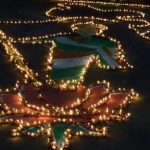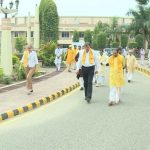It is a wish of almost all the staunch Hindu followers to visit to Kasi also known as Varnasi at least once in their lifetime. But travelling to Kasi from south India is still considered a Herculean task for a average person not due to financial issues, but the time it takes is something beyond people’s imagination.
To compensate non-ability to visit Kasi, Rameshwaram in Tamil Nadu is also termed as Dakshina Kasi (south India’s Varnasi). But it is also said that a visit to the six Shiva temples on the banks of Kaveri river is equivalent to paying a visit to Kasi. It is believed that the Sins of the ancestors will be resolved by a visit to these temples. And what better occasion would be to visit these temples than Kaveri Pushkaram. Religionworld provides you the lineup of six temples, for you to plan a visit:
The list of temples on Kaveri banks are : Thiruvaiyaru, Thiruvidaimarudur, Mayiladuthurai, Sayavanam (Near Poompuhar), Thiruvengadu, Thiruvanjiam (Srivanchiyam)
Aiyarappar temple (Thiruvaiyaru)
Aiyarappar Temple is a temple dedicated to Lord Shiva in Tiruvaiyaru. The temple is incarnated by the hymns of Thevaram and is classified as Paadal Petra Sthalam. Thiruvaiyaru means Five Rivers around the city. The Five Rivers are Arisilaaru, Vennaaru, Vettaaru, Kudamuruttiyaaru and Kaaviriyaaru.

The temple is known as “Dakshina Kailasam”. The Temple has “5 prakarams” and many ‘mandapams’ . The Tiruvaiyaru temple has also a shrine for Aatkondar or Kalasamharamoorthy. A Homa Kund started by saint Adi Sankara can be found outside the shrine of Aatkonda. While the presiding deity of temple is named after the five rivers, there are five water bodies in the temple namely Surya Pushkarani, Ganga Theertham, Chandra Pushkarani, Palaru and Nandi Theertham. The temple is considered the foremost among the seven Sapthastanam temples. The temple is believed to have been built by sage Neymasa at the order of Shiva. There are two shrines named Dakshina Kailasam and Uttara Kailasam. Uttarakailasam was built by Rajaraja Cholan’s queen in the late 10th century who also made several endowments . Dakshinakailasam was renovated by Rajendra Cholan’s queen. There is a Mukthi mandapam where Panchaksara japam is performed.
Mahalingeswaraswamy Temple (Thiruvidaimarudur)
Mahalingeswaraswamy Temple is a temple dedicated to the deity Shiva, located in Tiruvidaimaruthur and is the most significant one the banks of River Kaveri considered on par with Kasi. According to legend, Mahalingaswamy is the centre of all Shiva temples in the region and the Saptha Vigraha moorthis (seven prime consorts in all Siva Temples) are located at seven cardinal points around the temple, located in various parts of the state.

Shiva is worshiped as Mahalingeswaraswamy, and is represented by the lingam, with his idol referred to as Jothimayalingam in this Temple. His consort Parvati is depicted as Pirguchuntaragujambigai.
The presiding deity is revered in the 7th century Tamil Saiva canonical work, the Tevaram, written by Tamil saint poets known as the nayanars and classified as Paadal Petra Sthalam. The 9th century Saiva saint poet Manikkavasagar has sung praise about the temple in his works.
There are 149 inscriptions associated with the temple indicating contributions from Pandyas, Cholas, Thanjavur Nayaks and Thanjavur Maratha kingdom. The present masonry structure was built during the Chola dynasty in the 9th century, while later expansions are attributed to Thanjavur Nayaks during the 16th century.
The temple complex is one of the largest in state and it houses four gateway towers known as gopurams. The temple has numerous shrines, with those of Mahalingeswaraswamy, Pirguchuntaragujambigai and Mookambigai being the most prominent. The temple complex houses many halls and three precincts; the most notable is the second precinct built during the Vijayanagar period that has many sculptures.
Mayuranathaswami Temple, (Mayiladuthurai)
Mayiladuthurai is the place where the Kaveri Pushkarams 2017 has begun, here we have the famous Mayuranathaswami Temple dedicated to the Hindu god Shiva and has given its name to the town itself. This is one among the iconic Shiva Temples which are considered to be on par with Kasi.

The presiding deity is the “Swayambu lingam” called as Mayuranathar because the goddess Parvathi worshipped Shiva here in the form of a “Mayura”. According to mythology, the goddess Parvathi, once offended Shiva, and the annoyed Shiva cursed Parvathi to be born as a lowly peahen. Later, when Parvathi repented, Shiva reduced this sentence. Parvathi had to pray first at Mylapore and then at Mayiladuthurai, at the end of which she was ridden of her curse and became known as “Abhayambal”. It is believed that Brahma, Lakshmi, sage Agastya, Manmatha, birds and animals worshipped Mayuranathar.
The temple was built by the Medieval Cholas. The oldest inscriptions on the temple walls date to the time of Kulothunga Chola I. The gopura at the eastern entrance to the temple is nine storeys high. The idol of Durga near the northern entrance of the temple is expertly sculpted and differs from those in other temples. On the temple walls, there is the sculpture of a devotee trying to sever his head as an offering to the God.
On the day of the new moon in the Tamil month of Aippasi (November–December), religious Hindus have a ceremonial bath in the temple tank as it is believed to purify them from sins. An annual dance festival called the Mayura Natyanjali festival is celebrated within the precincts of the temple each year.
Must Read: Kaveri Pushrakrams 2017 : Popular Temples on the Banks of Kaveri
Sayavanam Chayavaneswarar Temple (Sayavanam)
Sayavanam Chayavaneswarar Temple is located on the banks of Kaveri in Sayavanam . Its historical name is Tiru Chaikadu and the presiding deity is Shiva as Swayambu murthi. He is called as Chayavaneswarar and his consort is known as Kuyilinum Inia Mozhiyal. This temple is among the six temples in Kaveri river bank which are equivalent to Kasi.
It is one of the shrines of the 275 Paadal Petra Sthalams – Shiva Sthalams glorified in the early medieval Tevaram poems by Tamil Saivite Nayanars Tirugnanasambandar and Tirunavukkarasar.

Chola King Kotchengannan built many Shiva temples, majority of them are of Mada style. Mada temples are the ones in which an elephant cannot enter. This is also a Mada temple. The temple of Champagi Amman, guardian deity of Poompuhar is nearby the temple. The tank is on the south side. In the place of Kodimaram the flag post, Lord Vinayaka is in the place. As this is a Mada type temple, Nandhi is on a higher level. There are shrines of Sun, Indira, Iyarpagai Nayanar with his wife in the outer prakara. There is also a shrine for the three saivite saints.
Iyarpagai Nayanar, one among the 63 nayanars was born and attained salvation in this place. His wife was equally a Shiva devotee. To prove the highest standard of his Bhakti, Lord Shiva came to his house as a devotee and demanded his wife to be presented to him. Nayanar had no hesitation and offered her instantaneously. Wife did not object. Nayanar asked the devotee what he should do next. The guest devotee said that Nayanar should accompany him with his wife as an escort as the people of the place and his relatives could attack them. Nayanar agreed and escorted them with a long sword till the border of the place. Nayanar resisted the opposition of the people and took the guest Shiva devotee safely till the border. He was asked to return then. All of a sudden, the devotee disappeared. Lord Shiva with Mother Uma appeared and said that the play was staged to prove Nayanar’s Shiva Bhakthi, blessed him with all longevity and promised salvation to him.
Swetharanyeswarar Temple (Thiruvenkadu)
Swetharanyeswarar Temple is a Hindu temple located in the town of Thiruvenkadu with the main deity is Shiva as Swayambu “Swetharanyeswarar” (lord of white forest”) and the goddess is Brahma “Vidya ambal”. This temple is among the six temples in cauvery river bank which are equivalent to Kasi.
There is a separate Sannidhi for Budha (mercury). The temple is quite large and all four important Saivite saints have sung in praise of this lord.

This temple is especially known for its unique incarnate of Lord Shiva called “Agora Murthi”. He is one of the main god who is being prayed in this village. According to the legend “Agora Murthi” was one of the furious incarnation of Lord Shiva. There was an Evil named “Maruthuvasuran” in Thiruvengadu. He acquired powers from Lord Brahma after Meditation and used those powers in a wrong ways. As he started to torturing the saints and innocent people, the saints and people requested Lord Shiva to put an end to this evil. Lord Shiva took his incarnation ‘Agora murthi’ and killed the ‘Maruthuvasuran under a tree (which is now in Thiruvengadu temple, back to the entrance of Agora murthi). The place is called by other names like Swetaranyam, Adi Chidambaram and Nava Ntirya Stala.
It is believed that Indira, Airavatam, Budha (Jupiter), Sun God and Moon God said to have worshipped God Shiva here. From the stone inscriptions found inside this temple, it is seen that the earlier Chola kings Aditya Chola and Rajaraja Chola have made a lot of contributions to this temple.
Thiruvengadu village is also famous for its unique structure of pools in temples. This temple has 3 pools, 3 Gods. It is a belief that who takes bath in all these pools, the one will be free from their problems.
Sri Vanchinadha Swamy temple
Sri Vanchinadha Swamy temple is at the centre of the village. The central deity of the temple of the temple is the Lord Vanchinadar, a form of the Lord Shiva, and his consort is Mangalanayaki. This temple is among the six temples in cauvery river bank which are equivalent to Kasi.

The temple is over 1100 years old, and was built by the kind Rajendra Chola in the year 850 AD. One of the unique features of this temple is the separate shrine to the Hindu god of Death and Justice, Lord Yama. In the tradition of this temple, visitors make a visit to the shrine of Yama first before entering the temple, unlike in other temples where the Lord Ganesha is propitiated first. The temple also has two statues of Nandi, one on the east side and one on the west.
Must Read : Kaveri Pushkaram 2017 : All You Need to Know
Must Read : #KnowYour Rivers : Kaveri River









